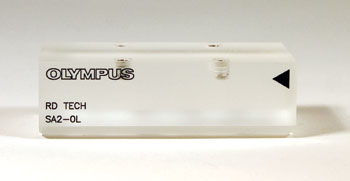Phased Array Wedges
In addition to the array transducer itself, phased array probe assemblies usually also include a plastic wedge. Wedges are used in both shear wave and longitudinal wave applications, including straight beam linear scans. These wedges perform basically the same function in phased array systems as in conventional single element flaw detection, coupling sound energy from the transducer to the test piece in such a way that it mode converts and/or refracts at a desired angle in accordance with
Snell's Law. While phased array systems do utilize beam steering to create beams at multiple angles from a single wedge, this refraction effect is also part of the beam generation process. Shear wave wedges look very similar to those used with conventional transducers, and like conventional wedges they come in many sizes and styles. Some of them incorporate couplant feed holes for scanning applications. A typical phased array wedge is seen below.
Zero-degree wedges are basically flat plastic blocks that are used for coupling sound energy (and for protecting the transducer face from scratches or abrasion) in straight linear scans and also for low-angle longitudinal wave angled scans.

Wedges can also be custom contoured to accommodate complex part geometries. There are several wedge dimensions in addition to incident angle that are used in programming phased array scans, to insure proper distance and depth calibration as well as proper refracted angle. These parameters will be listed in the manufacturer's wedge documentation and should be recorded for reference.